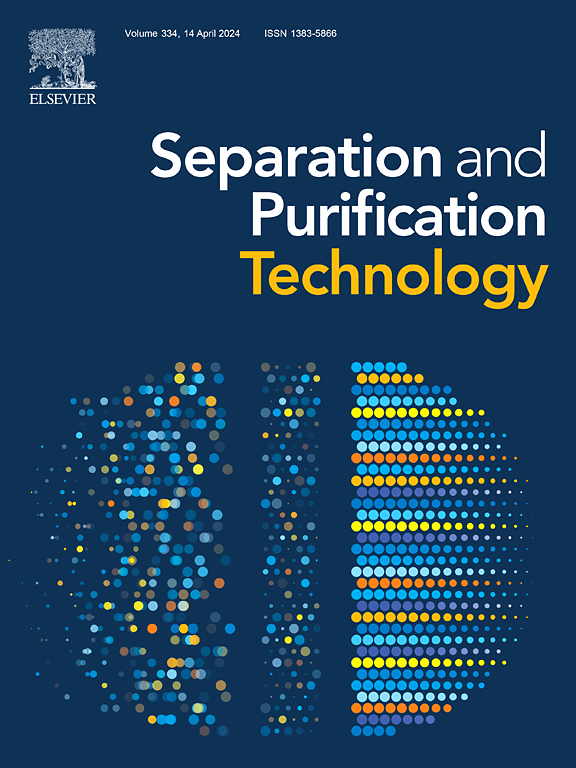Nano-armored super-hydrophilic antifouling membrane through dual counter-diffusion-induced process for separation of crude oil emulsion
IF 8.1
1区 工程技术
Q1 ENGINEERING, CHEMICAL
引用次数: 0
Abstract
Conventional superhydrophilic membrane surfaces effectively resist low-viscosity oil stains, but it is difficult to avoid crude oil adhesion. There is still room for improvement in the anti-fouling performance throughout the crude oil emulsion separation process. Using metal salts and phytic acid molecules as building blocks, a nano-armored superhydrophilic metal-phytic acid coordination self-assembled membrane (M−PA/CAM) is prepared with a dual counter-diffusion-induced strategy. Strong Lewis acid Fe3+ ions are easily coordinated with Lewis base phytic acid to form a three-dimensional cross-linked network. The addition of NaCl to the coagulation bath resulted in an increase in surface roughness. Therefore, the optimized Fe-PA/CAM have a high porosity of 60.9 % and a roughness of 182 nm, showing superhydrophilicity and underwater superoleophobicity. The pure water permeability is capable of reaching 805.9 L m-2h−1 bar−1. After 3.0h of circulating filtration, a 1000 ppm crude oil-in-water emulsion can reach a recovery rate of 99 %. Compared with PA-Fe modified PVDF membranes prepared by impregnation and blending methods, the permeation attenuation rate of Fe-PA/CAM is reduced by more than 50 %. The coating had strong hydration capacity, verified by in-situ DRIFTS analysis of water adsorption kinetics. Both the Young’s modulus and tensile strength exceeded PVDFM by 1.9 and 1.4 times respectively. The composite membrane exhibits chemical and mechanical stability and shows promise in actual oily wastewater treatment.

纳米铠装超亲水性防污膜通过双重反扩散诱导工艺分离原油乳化液
传统的超亲水膜表面能有效抵抗低粘度油渍,但难以避免原油的粘附。在整个原油乳化液分离过程中,其防污性能仍有提高的空间。以金属盐和植酸分子为基础,采用双反扩散诱导策略制备了纳米超亲水性金属-植酸配位自组装膜(M - PA/CAM)。强Lewis酸Fe3+离子容易与Lewis碱植酸配位形成三维交联网络。在混凝液中加入NaCl,使表面粗糙度增加。因此,优化后的Fe-PA/CAM具有60.9 %的高孔隙率和182 nm的粗糙度,具有超亲水性和水下超疏油性。纯水渗透率可达805.9 L m-2h−1 bar−1。循环过滤3.0h后,1000 ppm的水包油乳状液回收率可达99 %。与浸渍法和共混法制备的PA-Fe改性PVDF膜相比,Fe-PA/CAM的渗透衰减率降低了50% %以上。该涂层具有较强的水化能力,并通过原位DRIFTS吸附动力学分析得到验证。杨氏模量和抗拉强度分别是PVDFM的1.9倍和1.4倍。复合膜具有良好的化学性能和机械性能,在实际含油废水处理中具有广阔的应用前景。
本文章由计算机程序翻译,如有差异,请以英文原文为准。
求助全文
约1分钟内获得全文
求助全文
来源期刊

Separation and Purification Technology
工程技术-工程:化工
CiteScore
14.00
自引率
12.80%
发文量
2347
审稿时长
43 days
期刊介绍:
Separation and Purification Technology is a premier journal committed to sharing innovative methods for separation and purification in chemical and environmental engineering, encompassing both homogeneous solutions and heterogeneous mixtures. Our scope includes the separation and/or purification of liquids, vapors, and gases, as well as carbon capture and separation techniques. However, it's important to note that methods solely intended for analytical purposes are not within the scope of the journal. Additionally, disciplines such as soil science, polymer science, and metallurgy fall outside the purview of Separation and Purification Technology. Join us in advancing the field of separation and purification methods for sustainable solutions in chemical and environmental engineering.
 求助内容:
求助内容: 应助结果提醒方式:
应助结果提醒方式:


